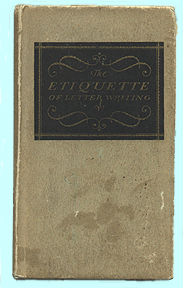
From Eaton, Crane & Pike Company's The Etiquette of Letter Writing, (1927 edition):
3. COMPOSING THE LETTER
The ordinary letter is started My dear Mrs. Black, while one to a more intimate friend commences, Dear Mrs. Jordan, or Dear Marianne.
Letters are written in the third person when replying to formal invitation, and it is also frequently used in writing to tradespeople, as for instance:
Mrs. John Brown wishes to inform
Peabody & Johnson that the curtains
ordered on the twenty-third of April
have not been received, etc.
There is no fixed rule for the sequence of pages in a letter, though, the usual custom is to start with the folded edge to the left as one begins the page, then to skip to the fourth page then back to the second, finishing on the third page. It is entirely correct, however, to start with the folded edge to the right as one begins the page, then to skip to the back page, then, opening the sheet, to write on the left-hand page, finishing on the right-hand page.
In closing a letter to a social acquaintance there are many forms one may use, Very sincerely, or Yours sincerely, being perhaps the most usual, Cordially, or Faithfully, showing a bit warmer acquaintance.
To a close friend or relative one signs oneself simply and naturally with spontaneous greeting, such as Affectionately, Devotedly, With love, etc.
To a business acquaintance or a stranger, Very truly, or Yours very truly, suffices.
Initials are never correct in signing a letter. One should use the full name. A married woman signs her letters, Susan Caldwell Smith, and if she is in doubt as to whether the person to whom she is writing is acquainted with her married title, then she encloses it in a parenthesis below or else at the left, thus:
Susan Caldwell Smith
(Mrs. James Preston Smith)
An unmarried woman signs her full name and, in the circumstances just referred to, prefixes Miss to her name, thus:
(Miss) Adelaide Royce Seymour
A man signs himself Very truly yours, to a woman he barely knows or to one he is addressing in a business way. In a letter of condolence it is gracious for a man to use some such conclusion as, I am yours very faithfully.
Letters to servants are written very simply, My dear Mary, or My dear John, and signed, Very truly, M. T. Wilkins. They are addressed, Mary Burns, or Mrs. Mary Burns, or Mr. John White. This holds good also for the servants one knows in a friend's house, but in writing to a servant who is a stranger, the third person is used.
Envelopes are addressed with the full name of the person to whom the letter is sent if the name is not too long. The street address and city and state should be spelled out. Abbreviations suggest careless haste.
A letter to a woman is always addressed to Miss or Mrs.; a man's to Mr., and a boy's to Master. Many prefer to omit Mr. or to address a man's letter and add Esq., which is equally correct, and is preferred in Great Britain.
However, is a man is addressed as junior it is obviously incorrect to prefix Mr. to his name. Thus a letter is addressed to John Williams, junior, never to Mr. John Williams, junior.
A wife is never addressed by her husband's title. A woman doctor is addressed socially as either Doctor Mary T. Waite, or Mrs. Frederick Waite.
OTHER TOPICS


Slipcue Mail Bag
Press Clippings & Print Reviews
